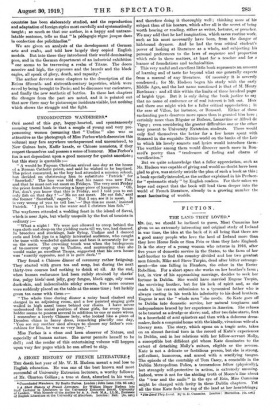GERMAN ART.*
M DB LA SIZERANNE pertinently asks : " What is the art of these people ? And what can these artists do, who signed the
Appeal to the civilized world,' to replace in the aesthetic patrimony of mankind the wonderful things which they abolished in the portal of Reims ? " Can these German artists claim to have produced anything comparable with what they have destroyed, or are they merely trying to attract attention by the methods of the suffragette who smashed the Venus of Velasquez in order to advance the cause of women's rights ? M. de la Sizeranne tells us that.since 1888 he has been studying.German painting, and his silence regarding its merits has not been occasioned by the horrors of Louvain and Seulis, but because there was nothing to praise. The older school of German painters, Menzel and his contemporaries, whose subjects were Frederick the Great playing the flute, monks in beer-cellars, villagers tormented by Kobelds, and sentimental ,representations of the Rhine and its ruins, were not enough for the younger ,generation dreaming of world-conquest. They looked about
for inspiration and found it in the-Swiss Boecklin. This artist .lived in Italy, and his work was a frantic and despairing effort
to graft himself upon classic and Mediterranean art. Now.the true German spirit seems fundamentally incapable of .compre,heading Antique or Italian figure art, and Boecklin, though
Swiss, was of German race. He threw over the traditional style in which his forerunners, fromHolbein downwards, had excelled— minute study of character and homely ways—and set out to
realize Olympus. In doing this he preserved all the material and animal part of his sirens, centaurs, and nymphs, but he missed their antique spirit, their rhythm harmony and purity of line. It was like a Greek statue seen in a distorting mirror.
One thing he did was to place these mythological beings in real surroundings—the satyr left his plinth to run about in a real wood, and -the centaur was taken down from the metope and with a crack of the whip set galloping in a field. From such a source the modern German painters in search of something great and powerful took their inspiration, resulting in " the constant negation of the useful lessons of Holbein, and a constant pretension to _great synthetic contours, to vast symbols, to mural decoration, and to philosophy, expressed by drawing the most common, the most vulgar, and the most lamentably academic. It is there that the German artists stopped, there that they thought they had found the revivifying idea of Germanic painting ! Franz Stuck, Max Klinger, Triibner, Wilhelm Bader, and a hundred others start from this."
It would seem that German artists determined to assume .a style bold and dominating in order to show the world what great peoplethey were, heedless of the fact that the style was a borrowed
one. But as M. de la Sizeranne points out, nothing was done spontaneously, and the pictorial and decorative art of other countries has been elaborately studied, and the reproduction and adaptation of foreign styles most carefully and systematically taught ; so much so that our author, in a happy and untranslatable sentence, tells us that " la pedagogie regne jusque dans Is confection des polichinelles."
We are given an analysis of the development of German arts and crafts, and told how largely they copied English models. But into these they introduced their world-dominating pose, and in the German department of an industrial exhibition one seems to be traversing a realm of Titans. The doors massive and high, the cypresses and the laurels and the black eagles, all speak of glory, death, and rapacity."
The author devotes some chapters to the description of the Reims fifteenthand sixteenth-century tapestries, which were saved by being brought to Paris ; and he discusses war caricature, and finally the new aesthetic of battles. In these last chapters the changes from the past are noted, and it is pointed out that now there may be picturesque incidents visible, but nothing which shows the struggle • and the fight.



































 Previous page
Previous page